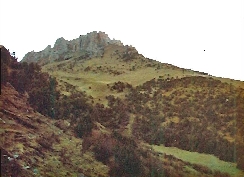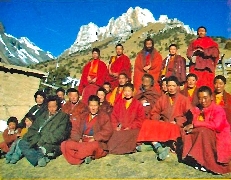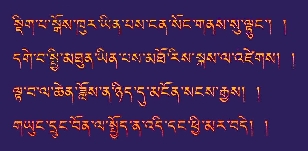 Shar Drol Dechen Yangwen Ling was founded by Kalsang Dagpa Shelzhig
in the 17th century. For generations it was known as a place where
Bön and Buddhist practitioners
- monks, yogis, and lay practitioners -
attained high levels of meditative experience.
The lineage of Shelzig has been continuously maintained at the
center through teachings of the Dzogchen texts Yabse Sum and
Tsewang Bodyulma.
In 1959, Shar Drol Dechen Yangwen Ling was destroyed, and then
completely reduced to ruins during the cultural revolution.
Shar Drol Dechen Yangwen Ling was founded by Kalsang Dagpa Shelzhig
in the 17th century. For generations it was known as a place where
Bön and Buddhist practitioners
- monks, yogis, and lay practitioners -
attained high levels of meditative experience.
The lineage of Shelzig has been continuously maintained at the
center through teachings of the Dzogchen texts Yabse Sum and
Tsewang Bodyulma.
In 1959, Shar Drol Dechen Yangwen Ling was destroyed, and then
completely reduced to ruins during the cultural revolution.
 In 1980, the current Khenpo's root Lama, Thaye Rangdrol Rinpoche,
re-established Shar Drol Dechen Yangwen Ling as a meditation
center and invited Lungrig Namdak Rinpoche, lineage holder of
Shardza Rinpoche, to teach there. The center flourished and
soon there were about 100 practitioners receiving Dzogchen
and other meditation instructions in Shardza Rinpoche's lineage -
among them a young monk, Tenzin Yeshe, who was to become Khenpo
of Shar Drol Dechen Yangwen Ling in 2011.
In 1998 Thaye Rangdrol Rinpoche passed away and since then the
meditation center has been deteriorating, because there has been
nobody to oversee it.
In 1980, the current Khenpo's root Lama, Thaye Rangdrol Rinpoche,
re-established Shar Drol Dechen Yangwen Ling as a meditation
center and invited Lungrig Namdak Rinpoche, lineage holder of
Shardza Rinpoche, to teach there. The center flourished and
soon there were about 100 practitioners receiving Dzogchen
and other meditation instructions in Shardza Rinpoche's lineage -
among them a young monk, Tenzin Yeshe, who was to become Khenpo
of Shar Drol Dechen Yangwen Ling in 2011.
In 1998 Thaye Rangdrol Rinpoche passed away and since then the
meditation center has been deteriorating, because there has been
nobody to oversee it.
 In 2005, when
Geshe Tenzin Yeshe went to
Tibet to visit his family, there were about 50 monks and nuns
living at the meditation center. They asked him to stay and teach
and help rebuild the meditation center.
Between 2005 and 2011, Geshe Tenzin Yeshe has been teaching in the
West, and collecting donations for the reconstruction of
Shar Drol Dechen Yangwen Ling both as a monastery and as a
meditation center where any serious practitioner, male or female,
can go into meditation retreat and receive instructions.
In 2005, when
Geshe Tenzin Yeshe went to
Tibet to visit his family, there were about 50 monks and nuns
living at the meditation center. They asked him to stay and teach
and help rebuild the meditation center.
Between 2005 and 2011, Geshe Tenzin Yeshe has been teaching in the
West, and collecting donations for the reconstruction of
Shar Drol Dechen Yangwen Ling both as a monastery and as a
meditation center where any serious practitioner, male or female,
can go into meditation retreat and receive instructions.
Khenpo Tenzin Yeshe's appeal for donations for
Shar Drol Dechen Yangwen Ling
 In 2011 Geshe Tenzin Yeshe has been appointed Khenpo of
Shar Drol Dechen Yangwen Ling, and has returned to Tibet
to teach and instruct at Shar Drol Dechen Yangwen Ling
and to help with its reconstruction. Under his guidance,
Shar Drol Dechen Yangwen Ling has again become a center
in which meditation, in particular Dzogchen, is taught
at a high level to monks, nuns and lay practitioners alike.
Much reconstruction work remains to be done.
In 2011 Geshe Tenzin Yeshe has been appointed Khenpo of
Shar Drol Dechen Yangwen Ling, and has returned to Tibet
to teach and instruct at Shar Drol Dechen Yangwen Ling
and to help with its reconstruction. Under his guidance,
Shar Drol Dechen Yangwen Ling has again become a center
in which meditation, in particular Dzogchen, is taught
at a high level to monks, nuns and lay practitioners alike.
Much reconstruction work remains to be done.
 Shar Drol Dechen Yangwen Ling was founded by Kalsang Dagpa Shelzhig
in the 17th century. For generations it was known as a place where
Bön and Buddhist practitioners
- monks, yogis, and lay practitioners -
attained high levels of meditative experience.
The lineage of Shelzig has been continuously maintained at the
center through teachings of the Dzogchen texts Yabse Sum and
Tsewang Bodyulma.
In 1959, Shar Drol Dechen Yangwen Ling was destroyed, and then
completely reduced to ruins during the cultural revolution.
Shar Drol Dechen Yangwen Ling was founded by Kalsang Dagpa Shelzhig
in the 17th century. For generations it was known as a place where
Bön and Buddhist practitioners
- monks, yogis, and lay practitioners -
attained high levels of meditative experience.
The lineage of Shelzig has been continuously maintained at the
center through teachings of the Dzogchen texts Yabse Sum and
Tsewang Bodyulma.
In 1959, Shar Drol Dechen Yangwen Ling was destroyed, and then
completely reduced to ruins during the cultural revolution.
 In 1980, the current Khenpo's root Lama, Thaye Rangdrol Rinpoche,
re-established Shar Drol Dechen Yangwen Ling as a meditation
center and invited Lungrig Namdak Rinpoche, lineage holder of
Shardza Rinpoche, to teach there. The center flourished and
soon there were about 100 practitioners receiving Dzogchen
and other meditation instructions in Shardza Rinpoche's lineage -
among them a young monk, Tenzin Yeshe, who was to become Khenpo
of Shar Drol Dechen Yangwen Ling in 2011.
In 1998 Thaye Rangdrol Rinpoche passed away and since then the
meditation center has been deteriorating, because there has been
nobody to oversee it.
In 1980, the current Khenpo's root Lama, Thaye Rangdrol Rinpoche,
re-established Shar Drol Dechen Yangwen Ling as a meditation
center and invited Lungrig Namdak Rinpoche, lineage holder of
Shardza Rinpoche, to teach there. The center flourished and
soon there were about 100 practitioners receiving Dzogchen
and other meditation instructions in Shardza Rinpoche's lineage -
among them a young monk, Tenzin Yeshe, who was to become Khenpo
of Shar Drol Dechen Yangwen Ling in 2011.
In 1998 Thaye Rangdrol Rinpoche passed away and since then the
meditation center has been deteriorating, because there has been
nobody to oversee it.
 In 2005, when
In 2005, when
 In 2011 Geshe Tenzin Yeshe has been appointed Khenpo of
Shar Drol Dechen Yangwen Ling, and has returned to Tibet
to teach and instruct at Shar Drol Dechen Yangwen Ling
and to help with its reconstruction. Under his guidance,
Shar Drol Dechen Yangwen Ling has again become a center
in which meditation, in particular Dzogchen, is taught
at a high level to monks, nuns and lay practitioners alike.
Much reconstruction work remains to be done.
In 2011 Geshe Tenzin Yeshe has been appointed Khenpo of
Shar Drol Dechen Yangwen Ling, and has returned to Tibet
to teach and instruct at Shar Drol Dechen Yangwen Ling
and to help with its reconstruction. Under his guidance,
Shar Drol Dechen Yangwen Ling has again become a center
in which meditation, in particular Dzogchen, is taught
at a high level to monks, nuns and lay practitioners alike.
Much reconstruction work remains to be done.